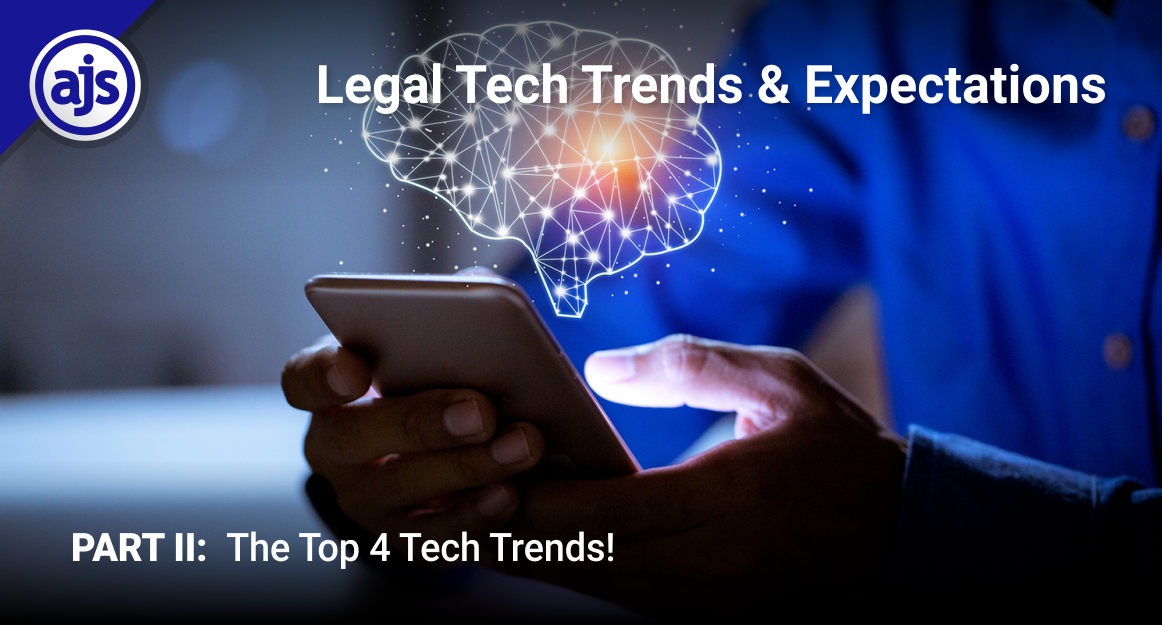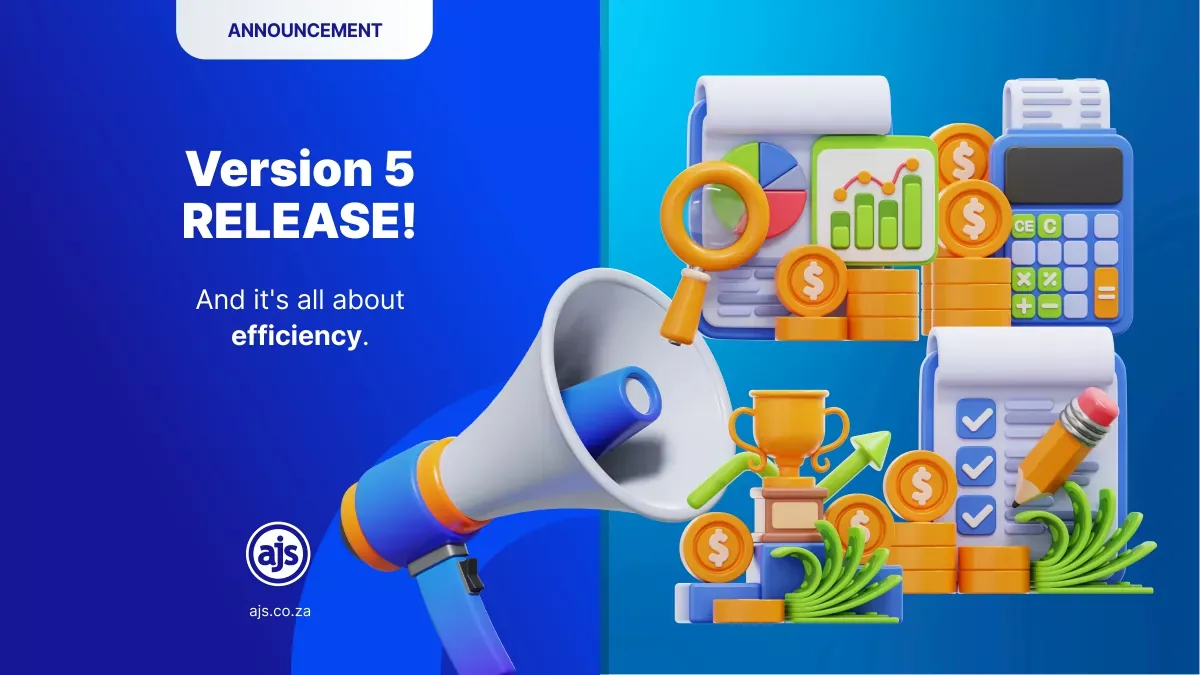
Legal Tech Trends and Expectations: PART 2
At the beginning of every year, it’s only natural that we would look at what’s trending around the globe. You know, just so that we all know what’s what and can plan ahead accordingly. At least that’s the situation when looking at the world of fashion and fashionistas.
But the same can also be said for technology and more specifically – legal tech. What’s happening on distant shores? What new releases are there? What should I be taking notice of? What should I look to incorporate into my business?
All relevant questions.
So, as we sit in anticipation waiting for the new tech trends to reveal themselves, our clients and readers are sure to be interested in what 2024 holds. Or at least what we think it will hold. And AJS can help you out by briefly discussing what we have come across.
With that said – legal tech needing very little introduction, pomp, or pageantry – let’s take a look at what legal tech trends have in store for us in 2024.
The top four tech trends
Data organisation and analytics
We all know that data is big business and high on the list of tech trends. In fact, and according to Darrow –
“the future of legal technology is data”.
One of the main concerns with data is the protection of it under the Protection of Personal Information Act 4 of 2013 and the European Union’s General Data Protection Regulation together with multiple laws and regulations around the globe.
But there is another issue with data, and that’s having data that’s unorganised and unstructured. If data is unstructured, it becomes very difficult to analyse for quality management purposes (at a minimum). Also having unstructured data means that a business cannot “optimise its performance, perform more efficiently, maximise profit, or make more strategically-guided decisions” (legalfutures).
So, in order to make the most out of data, organisations need to invest in refining and preparing their data repositories. Darrow sets out the following –
“AI algorithms, particularly those designed for tasks like data analysis, natural language processing (NLP), and pattern recognition, heavily rely on the quality and relevance of the input data. And thus, cleaning up data and document management systems (DMS) is a prerequisite for unleashing the full potential of AI”.
And we all know how big AI is right now.
Specific use-case GPTs
Chatbots aren’t anything new but what we’re talking about is a little more specific than a simple chatbot. Let’s start off by talking about GPTs. First-off, what are they? According to Zapier –
“GPT is a family of AI models built by OpenAI. It stands for Generative Pre-trained Transformer, which is basically a description of what the AI models do and how they work. The GPT models are designed to generate human-like text in response to a prompt. Initially, these prompts had to be text-based, but the latest versions of GPT can also work with images.
This allows GPT-based tools to do things like:
- Answer questions in a conversational manner.
- Generate blog posts and other kinds of short- and long-form content.
- Edit content for tone, style, and grammar.
- Summarise long passages of text.
- Translate text to different languages,
- Brainstorm ideas”.
Now that we have reminded ourselves what a GPT is we can get into the need for specific use case GPTs.
According to Mediate,
“One-size-fits-all may not work with law firms using generative pre-trained transformers, or GPTs. McDermott Will & Emery LLP’s Hunter Jackson, the firm’s chief knowledge officer, and Michael Shea, the chief information officer, told Law360 Pulse that specific GPT models will emerge in 2024 that are tailored for discrete practice groups, industries, tasks, and scenarios.
“These GPT models will combine vectorized information from various sources with custom GPT models that are trained on specialized datasets and objectives,” Jackson and Shea wrote to Law360 Pulse.
For example, some GPT models will be developed to conduct big data analysis on financial agreements. Other models will be used in e-discovery for locating relevant information from large collections of documents”.
ID verification software
Identity fraud is on the increase, as set out by Businesstech –
“The Southern African Fraud Prevention Services (SAFPS) has reported a significant increase in impersonation fraud, the number of forged documents and cases of money muling in South Africa.
According to SAFPS’s latest fraud statistics assessed between April 2022 and April 2023, impersonation fraud has increased by 356%”.
And that’s a frightening statistic!
There’s therefore a growing need to not only ensure systems are secure but to also ensure that the person logging onto a system is who they say they are – people need to be identified with accuracy. So, it makes perfect sense that businesses with access to secure data and who handle swathes of personal client information, need to ensure that those logging onto their servers are authorised to do so.
According to legalfutures –
“Legal firms will be looking at ways to incorporate these new requirements into their processes cost-effectively and compliantly. The use of Near Field Communications (NFC) technology to read the chip in an ePassport as a stand-alone ID check or used to verify who has signed a document or deed with 100% accuracy is now available and approved by HMLR for deed execution and DWP for Right to Work checks”.
Multipurpose AI Tools
While there’s an argument for specific use-case GPTs, businesses may lean more towards multi-purpose tools.
As set out by Mediate –
“corporations might transcend traditional departmental boundaries in their approach to generative AI and data.
In 2024, enterprises might try to navigate the AI cycle by following a multidisciplinary approach to AI adoption. In other words, AI tools will be shared across departments.
“Integrating expertise across data scientists, finance, engineering, and legal, among others, will lead to a more cross-functional, agile, and efficient enterprise-wide environment that capitalizes on cross-department data pools to up-level generative AI into a valued resource,” Bernadette Bulacan, the chief evangelist at contract management software company Icertis, wrote to Law360 Pulse”.
It appears that legal professionals will need to wear two hats in 2024 as they are asked to join cross-functional teams who are all pooling their resources and experiences into a project.
It will be an exciting time for in-house legal counsels who are often already expected to wear multiple hats. The only difference now is, they will have the proper tools at their disposal to work optimally and efficiently.
(Sources used and to whom we give thanks: Lexology; Darrow; Mediate; legalfutures and Businesstech).
To find out how to incorporate a new tool or tech trend into your existing accounting and practice management suite, feel free to get in touch with AJS – we have the right combination of systems, resources and business partnerships to assist you with incorporating supportive legal technology into your practice. Effortlessly.
AJS is always here to help you, wherever and whenever possible!
– Written by Alicia Koch on behalf of AJS





Leave a Reply